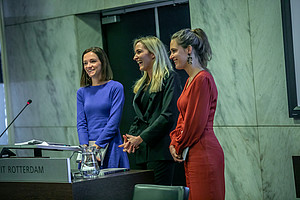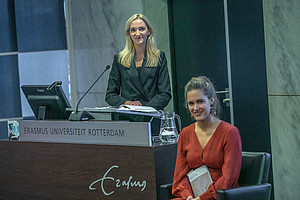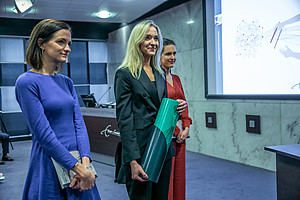PhD Defence Myrthe van Dieijen

In her dissertation ‘What’s in a Word: Economic Applications of Text Mining Methods’, Myrthe van Dieijen demonstrates how text can be used to both shape and answer research questions in business and economics research. It contains three papers, which each use a range of natural language processing methods, varying from sentiment to topic analysis. Myrthe van Dieijen will defend her dissertation in the Senate Hall at Erasmus University Rotterdam on Friday, 13 December 2019 at 11:30. Her supervisors are Prof. dr. P.H.B.F. Franses(ESE) and Prof. dr. R.L. Lumsdaine (EUR). Other members of the Doctoral Committee are Prof. dr. D.J.C. van Dijk (Erasmus School of Economics),Dr. L.H.J. Noordegraaf-Eelens (Erasmus School of Philosophy), Prof. dr F.M.G. de Jong (University of Utrecht), Prof dr. J.M. Berk (University of Groningen) and Drs. L.B.J. van Geest (Centraal Planbureau).
About Myrthe van Dieijen

Myrthe van Dieijen was born on the 30th of June 1989 in Sittard, the Netherlands. She obtained both her bachelor’s degree in Economics and Management Science as well as her master’s degree in Econometrics and Management Science cum laude at the Erasmus University Rotterdam. In 2014 she started her PhD project at the Erasmus Research Institute of Management. Her research was conducted at the Econometric Institute under the daily supervision of prof. dr. Philip Hans Franses and prof. dr. Robin L. Lumsdaine. She was a visiting scholar at Stanford University and the University of Southern California.
Myrthe’s research is situated at the intersection of marketing, finance and text mining. Her work has been published in the Industrial Marketing Management journal and presented at various international conferences, such as Marketing Science, Marketing Dynamics, and the ZEW Conference on the Economics of Information and Communication Technologies. She was a teaching assistant for Applied Econometrics and Time Series Analysis courses, and assisted in developing the first Massive Open Online Course (MOOC) in Econometrics on Coursera.
In addition to her academic work, Myrthe was selected for the talent program of the political party D66, and has co-written the ‘Techvisie’, which was presented officially to the Dutch Minister of Economic Affairs in 2016. In 2019 she launched her own sleepwear label, Le Nap, completely made from sustainable materials. She is currently working as a data scientist at Adidas, combining her interest in data science and the apparel industry.
Thesis Abstract

This dissertation demonstrates how text can be used to both shape and answer research questions in business and economics research. It contains three papers, which each use a range of natural language processing methods, varying from sentiment to topic analysis. The first chapter investigates whether volatilty in user-generated-content can spill over to volatility in stock returns, and which company events drive these dynamics. The findings show that in particular new product launches increase the volatility in user-generated content and that this volatility can spill over to stock returns. The second chapter of the thesis examines to which extent the Federal Reserve has balanced its dual mandate of price stability and maximum sustainable employment, by studying the topics of speeches by members of the Board of Governors of the Federal Reserve System. In addition, it provides evidence that after the financial crisis the Federal Reserve has unofficially adopted a third mandate of financial stability. The final chapter studies the role of the media as an intermediary of financial information. It compares central bank communications to the articles reporting on these communications to investigate if (and if so, in what way) the media distort information. The findings show that there is a large discrepancy between the original central bank communications and newspaper articles concerning those texts. The type of news outlet, the publication form (online versus print), type of financial text and journalist characteristics (e.g., relevant previous experience and high-quality degrees) all help explain the observed information distortion.
View photos of Myrthe's defence
Photos: Chris Gorzeman / Capital Images


